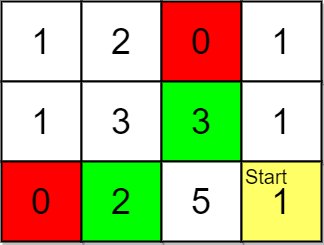2146-价格范围内最高排名的 K 样物品
给你一个下标从 0 开始的二维整数数组 grid ,它的大小为 m x n ,表示一个商店中物品的分布图。数组中的整数含义为:
0表示无法穿越的一堵墙。1表示可以自由通过的一个空格子。- 所有其他正整数表示该格子内的一样物品的价格。你可以自由经过这些格子。
从一个格子走到上下左右相邻格子花费 1 步。
同时给你一个整数数组 pricing 和 start ,其中 pricing = [low, high] 且 start = [row, col] ,表示你开始位置为 (row, col) ,同时你只对物品价格在 ** 闭区间** [low, high]
之内的物品感兴趣。同时给你一个整数 k 。
你想知道给定范围 内 且 排名最高 的 k 件物品的 位置 。排名按照优先级从高到低的以下规则制定:
- 距离:定义为从
start到一件物品的最短路径需要的步数( 较近 距离的排名更高)。 - 价格: 较低 价格的物品有更高优先级,但只考虑在给定范围之内的价格。
- 行坐标: 较小 行坐标的有更高优先级。
- 列坐标: 较小 列坐标的有更高优先级。
请你返回给定价格内排名最高的 k 件物品的坐标,将它们按照排名排序后返回。如果给定价格内少于 k 件物品,那么请将它们的坐标 全部
返回。
示例 1:

**输入:** grid = [[1,2,0,1],[1,3,0,1],[0,2,5,1]], pricing = [2,5], start = [0,0], k = 3
**输出:** [[0,1],[1,1],[2,1]]
**解释:** 起点为 (0,0) 。
价格范围为 [2,5] ,我们可以选择的物品坐标为 (0,1),(1,1),(2,1) 和 (2,2) 。
这些物品的排名为:
- (0,1) 距离为 1
- (1,1) 距离为 2
- (2,1) 距离为 3
- (2,2) 距离为 4
所以,给定价格范围内排名最高的 3 件物品的坐标为 (0,1),(1,1) 和 (2,1) 。
示例 2:

**输入:** grid = [[1,2,0,1],[1,3,3,1],[0,2,5,1]], pricing = [2,3], start = [2,3], k = 2
**输出:** [[2,1],[1,2]]
**解释:** 起点为 (2,3) 。
价格范围为 [2,3] ,我们可以选择的物品坐标为 (0,1),(1,1),(1,2) 和 (2,1) 。
这些物品的排名为:
- (2,1) 距离为 2 ,价格为 2
- (1,2) 距离为 2 ,价格为 3
- (1,1) 距离为 3
- (0,1) 距离为 4
所以,给定价格范围内排名最高的 2 件物品的坐标为 (2,1) 和 (1,2) 。
示例 3:

**输入:** grid = [[1,1,1],[0,0,1],[2,3,4]], pricing = [2,3], start = [0,0], k = 3
**输出:** [[2,1],[2,0]]
**解释:** 起点为 (0,0) 。
价格范围为 [2,3] ,我们可以选择的物品坐标为 (2,0) 和 (2,1) 。
这些物品的排名为:
- (2,1) 距离为 5
- (2,0) 距离为 6
所以,给定价格范围内排名最高的 2 件物品的坐标为 (2,1) 和 (2,0) 。
注意,k = 3 但给定价格范围内只有 2 件物品。
提示:
m == grid.lengthn == grid[i].length1 <= m, n <= 1051 <= m * n <= 1050 <= grid[i][j] <= 105pricing.length == 22 <= low <= high <= 105start.length == 20 <= row <= m - 10 <= col <= n - 1grid[row][col] > 01 <= k <= m * n
方法一:广度优先搜索
思路与算法
根据题意,我们需要求出所有感兴趣物品的距离、价格以及行列坐标。为了求出起点 start 到某件物品的最短路径,我们可以使用广度优先搜索,并在搜索的过程利用数组 items 来统计感兴趣物品的信息。具体地,items 中的每个元素为 (d, \textit{price}, x, y),其中 d 为物品坐标相对起点的最短距离,price 为物品价格,(x, y) 为物品的行列坐标。
在广度优先搜索的过程中,我们在队列 q 中保存 (x, y, d) 三元组,其中 (x, y) 为当前的行列坐标,d 为当前坐标相对起点的最短距离。
我们首先将起点对应的三元组 (\textit{start}[0], \textit{start}[1], 0) 加入队列。如果起点对应的物品价值在感兴趣的范围内,我们也需要将该物品的相关信息 (0, \textit{grid}[\textit{start}[0]][\textit{start}[1]], \textit{start}[0], \textit{start}[1]) 放入 items 数组。
在遍历到 (x, y) 时,我们枚举它上下左右的相邻坐标 (n_x, n_y),此时会有以下几种情况:
(n_x, n_y) 不合法或 grid}[n_x][n_y] = 0,此时无需进行任何操作;
grid}[n_x][n_y] = 1 或不在 [\textit{low}, \textit{high}] 区间内,此时该坐标无物品或物品价格不在感兴趣范围内,我们只需将 (n_x, n_y, d + 1) 加入队列 q;
grid}[n_x][n_y] 在 [\textit{low}, \textit{high}] 区间内,此时该坐标的物品在感兴趣的价格范围内,除了需要将 (n_x, n_y, d + 1) 加入队列 q 以外,我们还需要将该物品的距离、价格以及行列坐标 (d + 1, \textit{grid}[n_x][n_y], n_x, n_y) 放入 items 数组。
另外,为了避免重复遍历,我们需要在每个坐标(包括起点)加入队列时将 grid 中对应下标的数值修改为 0。
当遍历完成后,我们将 items 数组按照元素的字典序升序排序,亦即按照优先级从高到低的顺序排序。随后,我们用数组 res 统计 items 数组中前 k 个(若不满即为全部)物品的行列坐标,并将 res 数组返回作为答案。
代码
1 | class Solution { |
1 | class Solution: |
复杂度分析
时间复杂度:O(mn \log(mn)),其中 m, n 为 grid 的行数与列数。其中广度优先搜索求出可选择物品的时间复杂度为 O(mn),对物品按要求排序的时间复杂度为 O(mn \log(mn))。
空间复杂度:O(mn),即为保存符合要求物品信息的辅助数组的空间开销。